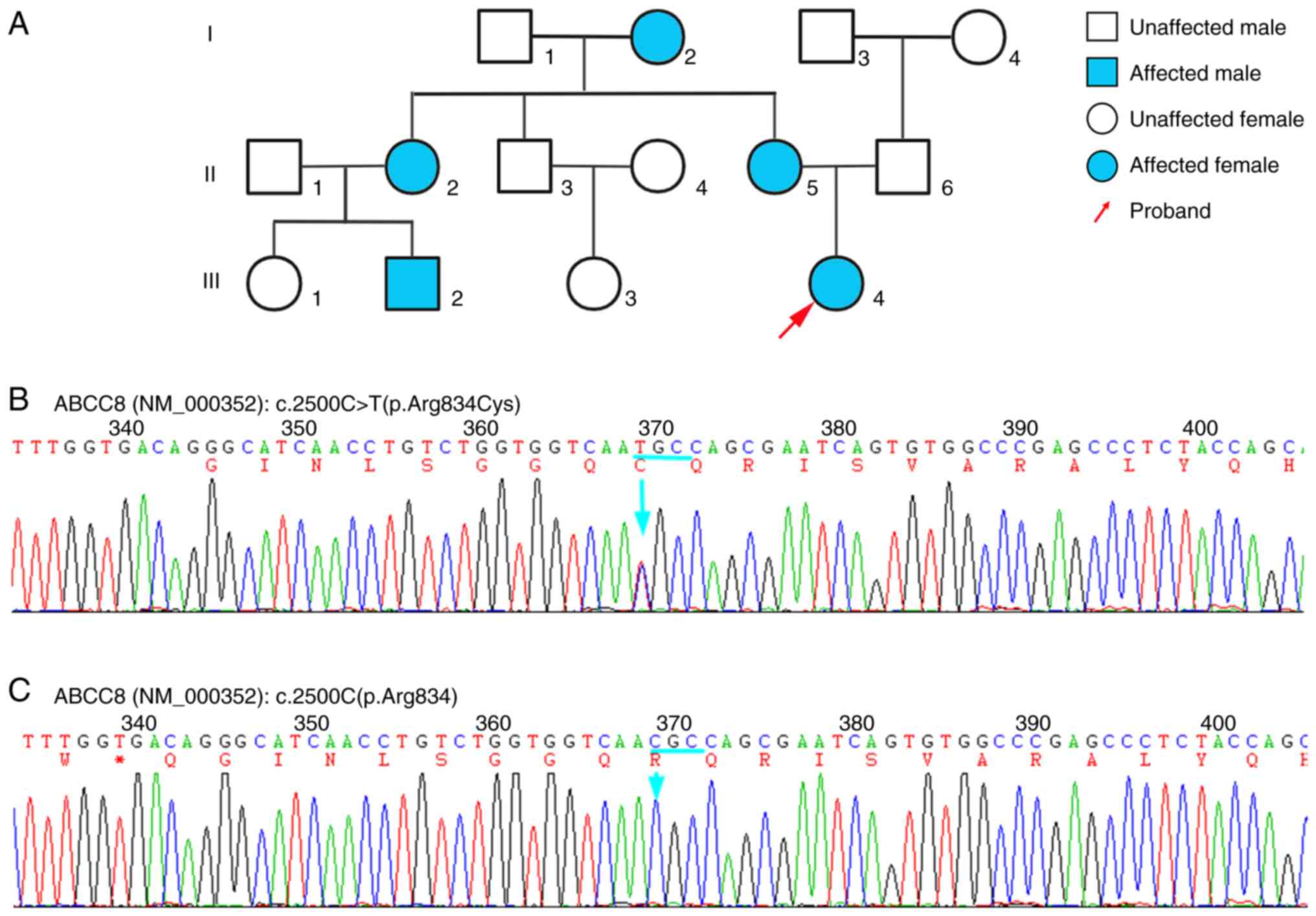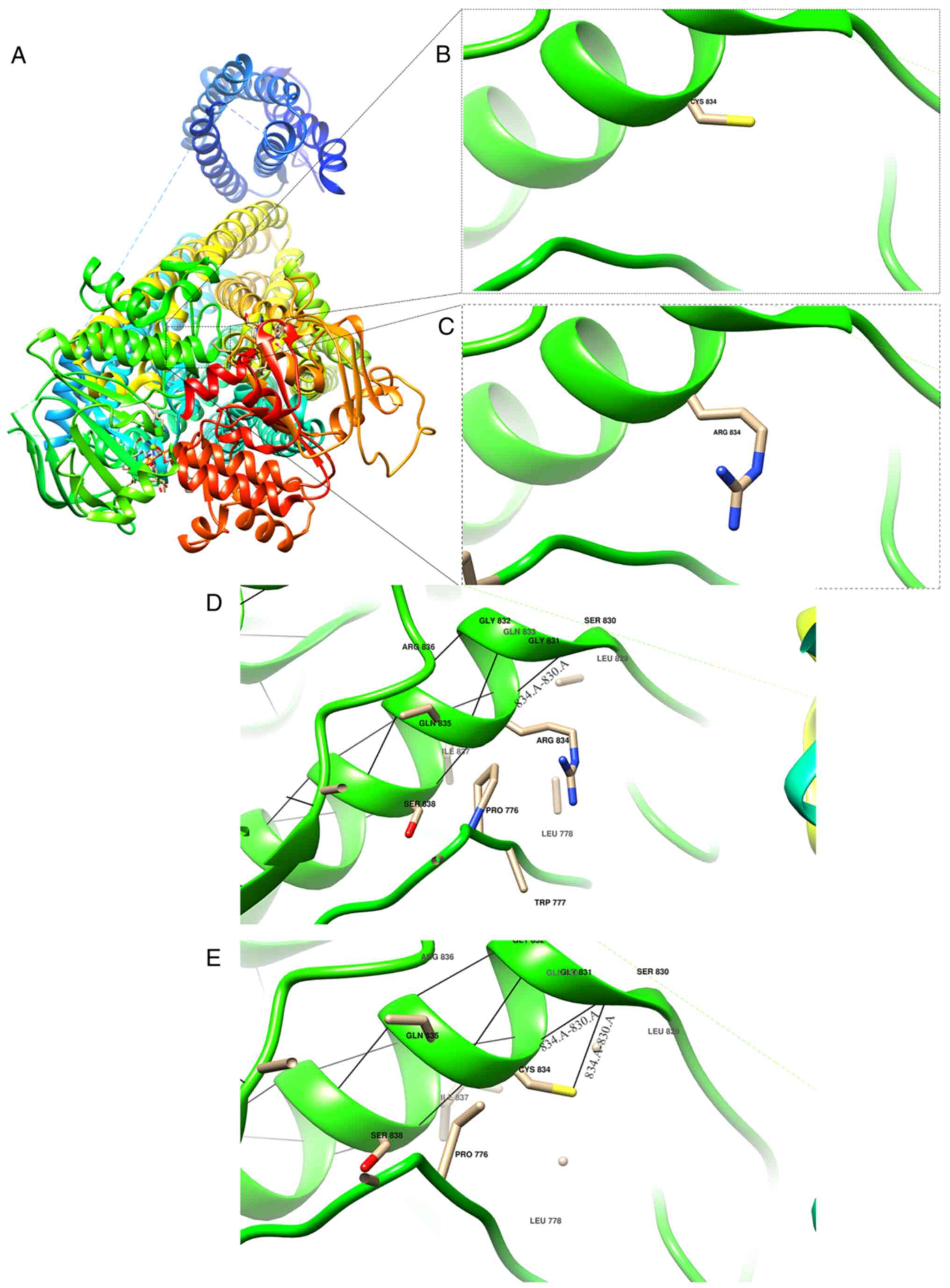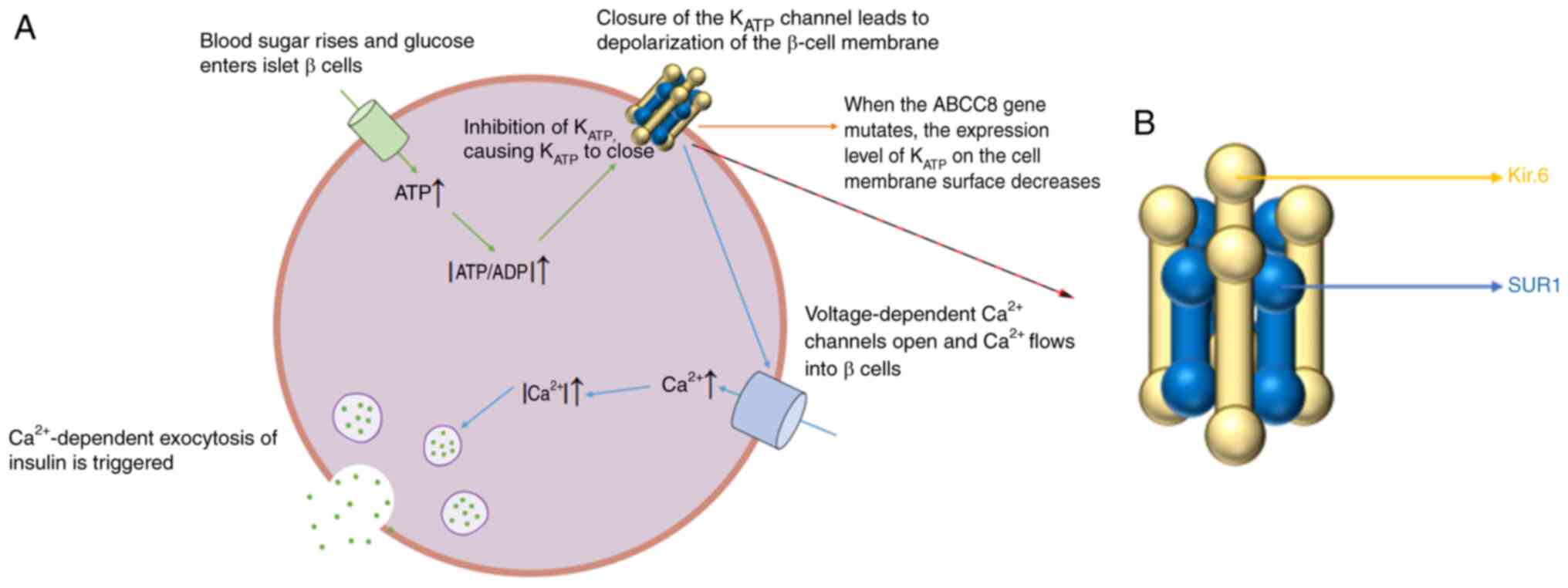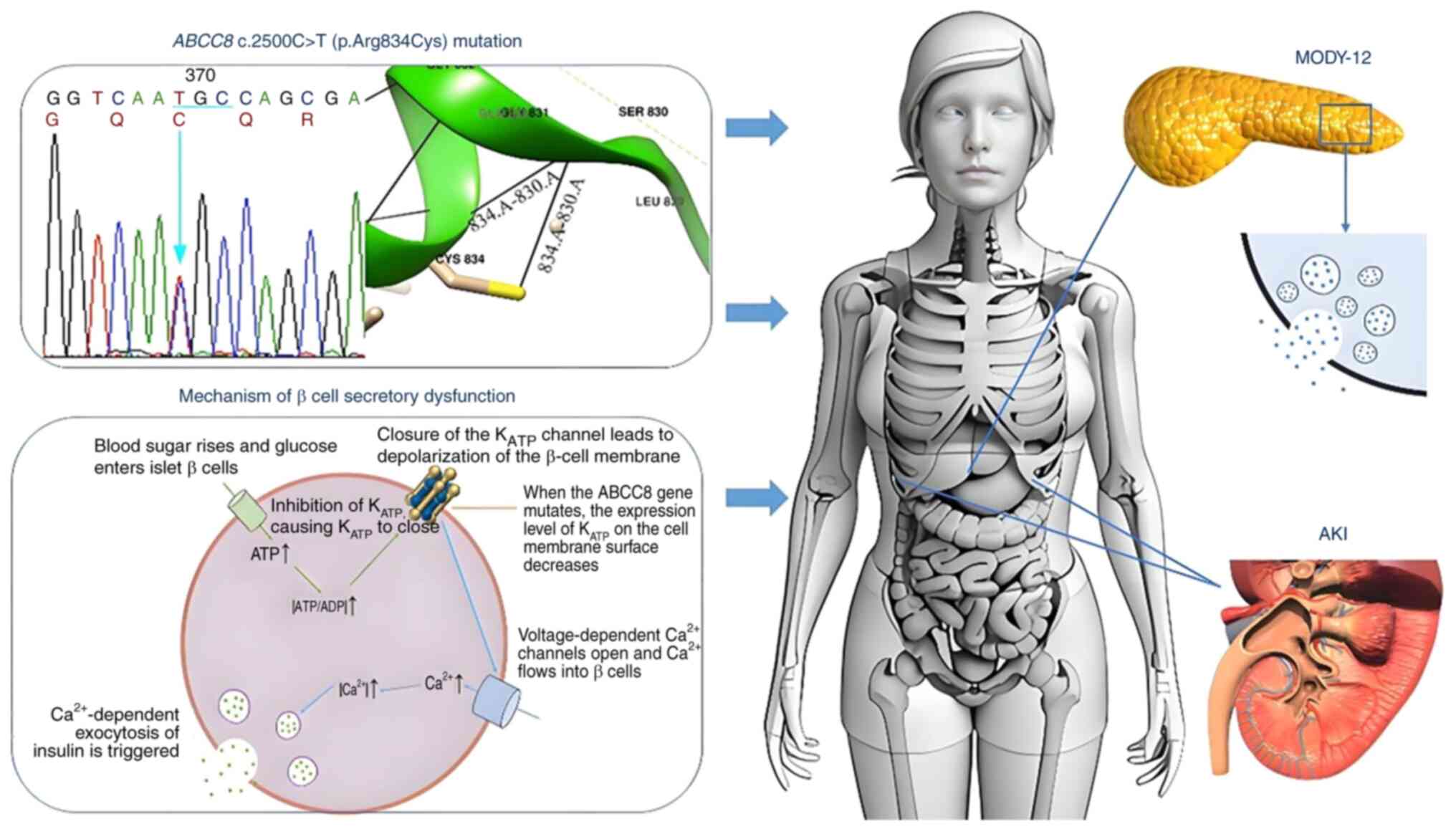|
1
|
Aarthy R, Aston-Mourney K, Mikocka-Walus
A, Radha V, Amutha A, Anjana RM, Unnikrishnan R and Mohan V:
Clinical features, complications and treatment of rarer forms of
maturity-onset diabetes of the young (MODY) - A review. J Diabetes
Complications. 35(107640)2021.PubMed/NCBI View Article : Google Scholar
|
|
2
|
Li J, Wang X, Mao H, Wen L, Deng A, Li Y,
Zhang H and Liu C: Precision therapy for three Chinese families
with maturity-onset diabetes of the young (MODY12). Front
Endocrinol (Lausanne). 13(858096)2022.PubMed/NCBI View Article : Google Scholar
|
|
3
|
Yahaya TO and Ufuoma SB: Genetics and
pathophysiology of maturity-onset diabetes of the young (MODY): A
review of current trends. Oman Med J. 35(e126)2020.PubMed/NCBI View Article : Google Scholar
|
|
4
|
Fajans SS and Bell GI: MODY: History,
genetics, pathophysiology, and clinical decision making. Diabetes
Care. 34:1878–1884. 2011.PubMed/NCBI View Article : Google Scholar
|
|
5
|
Shepherd M, Shields B, Hammersley S,
Hudson M, McDonald TJ, Colclough K, Oram RA, Knight B, Hyde C, Cox
J, et al: Systematic population screening, using biomarkers and
genetic testing, identifies 2.5% of the U.K. pediatric diabetes
population with monogenic diabetes. Diabetes Care. 39:1879–1888.
2016.PubMed/NCBI View Article : Google Scholar
|
|
6
|
Irgens HU, Molnes J, Johansson BB, Ringdal
M, Skrivarhaug T, Undlien DE, Søvik O, Joner G, Molven A and
Njølstad PR: Prevalence of monogenic diabetes in the
population-based norwegian childhood diabetes registry.
Diabetologia. 56:1512–1519. 2013.PubMed/NCBI View Article : Google Scholar
|
|
7
|
Tattersall RB and Fajans SS: A difference
between the inheritance of classical juvenile-onset and
maturity-onset type diabetes of young people. Diabetes. 24:44–53.
1975.PubMed/NCBI View Article : Google Scholar
|
|
8
|
Kant R, Davis A and Verma V:
Maturity-onset diabetes of the young: Rapid evidence review. Am Fam
Physician. 105:162–167. 2022.PubMed/NCBI
|
|
9
|
Ovsyannikova AK, Rymar OD, Shakhtshneider
EV, Voropaeva EN, Ivanoshchuk DE and Voevoda MI: MODY in
Siberia-molecular genetics and clinical characteristics. Diabetes
Mellitus. 20:5–12. 2017.(In Russ).
|
|
10
|
Richards S, Aziz N, Bale S, Bick D, Das S,
Gastier-Foster J, Grody WW, Hegde M, Lyon E, Spector E, et al:
Standards and guidelines for the interpretation of sequence
variants: A joint consensus recommendation of the American College
of medical genetics and genomics and the association for molecular
pathology. Genet Med. 17:405–424. 2015.PubMed/NCBI View Article : Google Scholar
|
|
11
|
Pettersen EF, Goddard TD, Huang CC, Couch
GS, Greenblatt DM, Meng EC and Ferrin TE: UCSF Chimera-a
visualization system for exploratory research and analysis. J
Comput Chem. 25:1605–1612. 2004.PubMed/NCBI View Article : Google Scholar
|
|
12
|
American Diabetes Association. 6. Glycemic
targets: Standards of medical care in diabetes-2019. Diabetes Care.
42 (Suppl 1):S61–S70. 2019.PubMed/NCBI View Article : Google Scholar
|
|
13
|
Ohta Y, Tanizawa Y, Inoue H, Hosaka T,
Ueda K, Matsutani A, Repunte VP, Yamada M, Kurachi Y, Bryan J, et
al: Identification and functional analysis of sulfonylurea receptor
1 variants in Japanese patients with NIDDM. Diabetes. 47:476–481.
1998.PubMed/NCBI View Article : Google Scholar
|
|
14
|
Olson TM and Terzic A: Human K(ATP)
channelopathies: Diseases of metabolic homeostasis. Pflugers Arch.
460:295–306. 2010.PubMed/NCBI View Article : Google Scholar
|
|
15
|
Fukuda Y, Aguilar-Bryan L, Vaxillaire M,
Dechaume A, Wang Y, Dean M, Moitra K, Bryan J and Schuetz JD:
Conserved intramolecular disulfide bond is critical to trafficking
and fate of ATP-binding cassette (ABC) transporters ABCB6 and
sulfonylurea receptor 1 (SUR1)/ABCC8. J Biol Chem. 286:8481–8492.
2011.PubMed/NCBI View Article : Google Scholar
|
|
16
|
De Franco E, Saint-Martin C, Brusgaard K,
Knight Johnson AE, Aguilar-Bryan L, Bowman P, Arnoux JB, Larsen AR,
Sanyoura M, Greeley SAW, et al: Update of variants identified in
the pancreatic β-cell K(ATP) channel genes KCNJ11 and ABCC8 in
individuals with congenital hyperinsulinism and diabetes. Hum
Mutat. 41:884–905. 2020.PubMed/NCBI View Article : Google Scholar
|
|
17
|
Babenko AP, Polak M, Cave H, Busiah K,
Czernichow P, Scharfmann R, Bryan J, Aguilar-Bryan L, Vaxillaire M
and Froguel P: Activating mutations in the ABCC8 gene in neonatal
diabetes mellitus. N Engl J Med. 355:456–466. 2006.PubMed/NCBI View Article : Google Scholar
|
|
18
|
Rafiq M, Flanagan SE, Patch AM, Shields
BM, Ellard S and Hattersley AT: Neonatal Diabetes International
Collaborative Group. Effective treatment with oral sulfonylureas in
patients with diabetes due to sulfonylurea receptor 1 (SUR1)
mutations. Diabetes Care. 31:204–209. 2008.PubMed/NCBI View Article : Google Scholar
|
|
19
|
Tarasov AI, Nicolson TJ, Riveline JP,
Taneja TK, Baldwin SA, Baldwin JM, Charpentier G, Gautier JF,
Froguel P, Vaxillaire M and Rutter GA: A rare mutation in
ABCC8/SUR1 leading to altered ATP-sensitive K+ channel activity and
beta-cell glucose sensing is associated with type 2 diabetes in
adults. Diabetes. 57:1595–1604. 2008.PubMed/NCBI View Article : Google Scholar
|
|
20
|
Proks P, Girard C and Ashcroft FM:
Functional effects of KCNJ11 mutations causing neonatal diabetes:
Enhanced activation by MgATP. Hum Mol Genet. 14:2717–2726.
2005.PubMed/NCBI View Article : Google Scholar
|
|
21
|
Yan FF, Lin YW, MacMullen C, Ganguly A,
Stanley CA and Shyng SL: Congenital hyperinsulinism associated
ABCC8 mutations that cause defective trafficking of ATP-sensitive
K+ channels: Identification and rescue. Diabetes. 56:2339–2348.
2007.PubMed/NCBI View Article : Google Scholar
|
|
22
|
de Wet H, Rees MG, Shimomura K, Aittoniemi
J, Patch AM, Flanagan SE, Ellard S, Hattersley AT, Sansom MS and
Ashcroft FM: Increased ATPase activity produced by mutations at
arginine-1380 in nucleotide-binding domain 2 of ABCC8 causes
neonatal diabetes. Proc Natl Acad Sci USA. 104:18988–18992.
2007.PubMed/NCBI View Article : Google Scholar
|
|
23
|
Ashcroft FM: ATP-sensitive potassium
channelopathies: Focus on insulin secretion. J Clin Invest.
115:2047–2058. 2005.PubMed/NCBI View Article : Google Scholar
|
|
24
|
Zinman B, Wanner C, Lachin JM, Fitchett D,
Bluhmki E, Hantel S, Mattheus M, Devins T, Johansen OE, Woerle HJ,
et al: Empagliflozin, cardiovascular outcomes, and mortality in
type 2 diabetes. N Engl J Med. 373:2117–2128. 2015.PubMed/NCBI View Article : Google Scholar
|
|
25
|
Davies MJ, D'Alessio DA, Fradkin J, Kernan
WN, Mathieu C, Mingrone G, Rossing P, Tsapas A, Wexler DJ and Buse
JB: Management of hyperglycemia in type 2 diabetes, 2018. A
consensus report by the American diabetes association (ADA) and the
European association for the study of diabetes (EASD). Diabetes
Care. 41:2669–2701. 2018.PubMed/NCBI View Article : Google Scholar
|
|
26
|
Kaze AD, Zhuo M, Kim SC, Patorno E and
Paik JM: Association of SGLT2 inhibitors with cardiovascular,
kidney, and safety outcomes among patients with diabetic kidney
disease: A meta-analysis. Cardiovasc Diabetol.
21(47)2022.PubMed/NCBI View Article : Google Scholar
|
|
27
|
DeFronzo RA, Norton L and Abdul-Ghani M:
Renal, metabolic and cardiovascular considerations of SGLT2
inhibition. Nat Rev Nephrol. 13:11–26. 2017.PubMed/NCBI View Article : Google Scholar
|
|
28
|
Hahn K, Ejaz AA, Kanbay M, Lanaspa MA and
Johnson RJ: Acute kidney injury from SGLT2 inhibitors: Potential
mechanisms. Nat Rev Nephrol. 12:711–712. 2016.PubMed/NCBI View Article : Google Scholar
|
|
29
|
Myers SR, Glaser NS, Trainor JL, Nigrovic
LE, Garro A, Tzimenatos L, Quayle KS, Kwok MY, Rewers A, Stoner MJ,
et al: Frequency and risk factors of acute kidney injury during
diabetic ketoacidosis in children and association with
neurocognitive outcomes. JAMA Netw Open. 3(e2025481)2020.PubMed/NCBI View Article : Google Scholar
|
|
30
|
Yang H, Yang L, Jardine MJ, Arnott C,
Neuen BL, Xu K, Zhao X, Qian D, Cui B, Qiu Y, et al: The
association between sodium-glucose cotransporter 2 inhibitors and
contrast-associated acute kidney injury in patients with type 2
diabetes undergoing angiography: A propensity-matched study. Eur J
Med Res. 29(621)2024.PubMed/NCBI View Article : Google Scholar
|
|
31
|
Chang YK, Choi H, Jeong JY, Na KR, Lee KW,
Lim BJ and Choi DE: Dapagliflozin, SGLT2 inhibitor, attenuates
renal ischemia-reperfusion injury. PLoS One.
11(e0158810)2016.PubMed/NCBI View Article : Google Scholar
|
|
32
|
Heyman SN, Rosenberger C, Rosen S and
Khamaisi M: Why is diabetes mellitus a risk factor for
contrast-induced nephropathy? Biomed Res Int.
2013(123589)2013.PubMed/NCBI View Article : Google Scholar
|
|
33
|
Errabelli P, Lathiya M and Singh D: Case
report: A case of pseudo-acute kidney injury due to
cyclin-dependent kinase inhibitor. Front Nephrol.
4(1389562)2024.PubMed/NCBI View Article : Google Scholar
|
|
34
|
Huang SK, Huang CY, Lin CH, Cheng BW,
Chiang YT, Lee YC, Yeh SN, Chan CI, Chua WK, Lee YJ and Ting WH:
Acute kidney injury is a common complication in children and
adolescents hospitalized for diabetic ketoacidosis. PLoS One.
15(e0239160)2020.PubMed/NCBI View Article : Google Scholar
|
|
35
|
Damman K and Testani JM: The kidney in
heart failure: An update. Eur Heart J. 36:1437–1444.
2015.PubMed/NCBI View Article : Google Scholar
|
|
36
|
Drozdzal S, Lechowicz K, Szostak B, Rosik
J, Kotfis K, Machoy-Mokrzyńska A, Białecka M, Ciechanowski K and
Gawrońska-Szklarz B: Kidney damage from nonsteroidal
anti-inflammatory drugs-Myth or truth? Review of selected
literature. Pharmacol Res Perspect. 9(e00817)2021.PubMed/NCBI View Article : Google Scholar
|
|
37
|
Deng K, Pei M, Li B, Yang N, Wang Z, Wan
X, Zhong Z, Yang Z and Chen Y: Signal pathways involved in
contrast-induced acute kidney injury. Front Physiol 2024; 15:
1490725.
|


















